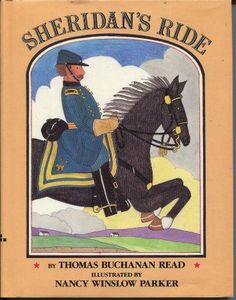“Sheridan’s Ride,” Read’s most famous work, was also published during his time of service to the government. A lyrical embodiment of General Phillip Henry Sheridan’s October 19, 1864, ride to rally Union troops at the battle of Cedar Creek, the poem’s patriotic theme and the general’s heroism encouraged audiences throughout the North. “The affrighted air with a shudder bore,” Read writes, “…Telling the battle was on once more, And Sheridan twenty miles away.” When the war ended, the Union League of Philadelphia commissioned Read to bring his textual design to life in a painting. This life-sized image depicts a stout General Sheridan courageously pushing forward towards Cedar Creek atop his horse, Rienzi, a galloping black stallion. Read also sculpted busts of the General.
Read wrote his most famous poem on November 1, 1964 and it was performed that evening by his friend James Murdock at the Pike's Opera House in Cincinnati as a benefit for Union soldiers. It was picked up by newspapers and then published by broadside and leaflet prior to the publication of this book.
|
|
| Illustrator |
Nancy Winslow Parker |
| LoC Classification |
PS2684.S5 1993 |
| Dewey |
811/.3 |
| Edition |
1st ed. |
| Nationality |
American |
| Dust Jacket |
dj |
| Cover Price |
$14.00 |
| No. of Pages |
31 |
| Height x Width |
9.3
x
7.2
inch |
|
|
|
|
born on March 12, 1822, in Corner Ketch, Pennsylvania. In 1841, Read moved to Boston and befriended famed poet Henry Wadsworth Longfellow and painter Washington Allston. The young artist was greatly influenced and encouraged by these two artists’ patriotic style and thematic content, Throughout the late 1840s and 1850s, spending the bulk of his time in Italy, Read established himself as one of the world’s leading artistic and literary voices.
With the outbreak of the Civil War in 1861, Read moved back to the United States and enlisted in the Union army. He served the north by giving readings, singing and reciting his civil war songs in military camps across the north.The literary work of his tenure as a soldier, The Wagoner of the Alleghenies, “The Oath,” and “The Defenders” were popular readings among Northern lecturers, as their pro-Union sentiments and unwavering sense of patriotism inspired the masses. As an exemplary piece of Read’s contemporary literary focus, “The Defenders” details the spirit of the Union symbolically through a description of the bald eagle. “True to its native sky, / Still shall our eagle fly,” reads the verse, “Casting his sentinel glances afar, / Though bearing the olive branch / Still in his talons staunch, / Grasping the bolts of the thunders of War!”
He returned to Italy after the war. in 1871, Read’s carriage overturned, leaving him badly injured and never able to fully recover. The next year Read left for the United States, dying soon after his arrival in a New York port om May 11, 1872. His body is buried on Laurel Hill in Philadelphia.
